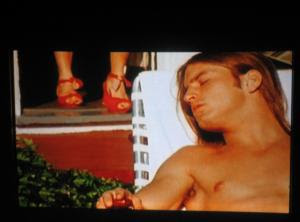Mind your own business. Tend to your own garden. Judge not lest ye be judged. Curiosity killed the....well, you get the drift.
The Wicker Man (1973) depicts the potentially horrifying consequences of meddling in other people’s affairs. A brilliantly satiric reversal of the conventional morality tale, this darkly humorous and thought-provoking masterpiece delves deeply into the quaint Celtic traditions and rituals of the ancient pagan holiday of May Day, as observed in countless small villages in England, Ireland, Scotland and Wales.
Filmed on location in and around Scotland, The Wicker Man takes place in a picturesque fictional seaside locale. Here on Summerisle, modernity takes a backseat to tradition, and the denizens of the island seem all the happier for it. They live simply, love freely, and eat, drink and make merry with lusty abandon, especially during the annual spring festivities.
Through the eyes of our protagonist, an uptight Protestant police detective investigating the case of a missing child, we learn the origins of delightful Celtic spring revelries such as dancing round the Maypole, and the quaint superstitious beliefs and practices of the earthy village folk who follow the Old Ways.
When Sergeant Howie (brilliantly portrayed by Edward Woodward) arrives on Summerisle to probe the townspeople about the mysterious disappearance of a teenage girl named Rowan Morrison, he is met with blank stares. No one here has ever even heard of Rowan Morrison, it seems. There must be some mistake. (Herein lies Howie’s first opportunity to walk away from the situation and let sleeping dogs lie.) Stubbornly and stonily, Howie refuses to accept this verdict, and doggedly trudges onward to uncover the secrets of this queer little village.
Howie’s persistence pays off, as he grills one strange character after another. We meet the schoolteacher who instructs the young children on the joys of sex (played by Diane Cilento); the lusty barmaid at the inn (gorgeous Britt Ekland, who bares all her charms in a seductive and spellbinding song and dance); and best of all, the elegant Lord Summerisle himself (Christopher Lee in the finest performance of his career), who, as the owner of the fruit groves that give the island its livelihood, presides over both the material and spiritual well-being of his Summerisle subjects.
Howie receives a new piece of the puzzle from each encounter, and is more convinced than ever that something evil is afoot. Yet each time Sergeant Howie hits a brick wall in his investigation, he’s given ample reason and opportunity to wrap up his inquest and return to the mainland. He refuses.
The God-fearing and closed-minded Howie grows more and more disgusted by what he perceives as their wanton pagan practices, and begins to fear the worst: that the townspeople will use the virgin Rowan Morrison (still unseen) as a human sacrifice to help Summerisle’s failing crops grow.
The film is a study in subtle artistry, and sneaks up upon the viewer with an oddly gentle appeal, with its lilting folk music, ribald humor and sexy situations. Then, at the point of no return, it hurtles unapologetically to its shocking and horrifying climax.
We have the indomitable Mr. Christopher Lee to thank for this fine film; it was Lee who brought the story to British Lion Films and shepherded its production. Written by the über-clever Anthony Shaffer (Sleuth) and directed by Robin Hardy, with memorable performances by Lee, Woodward, Cilento, Ekland and Ingrid Pitt, The Wicker Man is a true modern horror classic.


















































